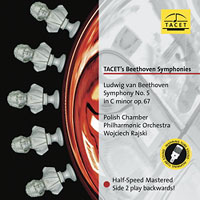Beethoven • Symphonies Wojciech Rajski conducting the Polish Chamber Philharmonic Orchestra  oming
of age in the 1960s, I was spared from overindulging in the Internet while forming my
opinions about music, musical performance and recorded sound. Instead, I sought out
criticism from stacks of old magazines. Many music critics of the day still felt that the
best performances of many classical pieces were those that I found so poorly recorded I
could not muster more than an academic interest. In other words, when I wanted to hear a
Beethoven performance, I turned to a more modern recording. Tastes have changed, and many
of these performances are now out of favor, but there is still some guilt associated with
enjoying a particularly well-recorded piece of music, as though that enjoyment comes at
the expense of another more definitive but less elegantly recorded version. oming
of age in the 1960s, I was spared from overindulging in the Internet while forming my
opinions about music, musical performance and recorded sound. Instead, I sought out
criticism from stacks of old magazines. Many music critics of the day still felt that the
best performances of many classical pieces were those that I found so poorly recorded I
could not muster more than an academic interest. In other words, when I wanted to hear a
Beethoven performance, I turned to a more modern recording. Tastes have changed, and many
of these performances are now out of favor, but there is still some guilt associated with
enjoying a particularly well-recorded piece of music, as though that enjoyment comes at
the expense of another more definitive but less elegantly recorded version.
These feelings haunted me when I sat down with this new set of Beethoven’s symphonies, six LPs each available separately, but the guilt was short-lived, because, like Goldilocks intruding in the home of the three bears, I found the combination of performance and sound to be just right for my tastes. Although little known in the US, the Polish Chamber Philharmonic Orchestra has been around for 35 years and has toured and recorded extensively. Conductor and founder Wojciech Rajski recorded this Beethoven cycle over ten years, from 2005 to 2015. The players use modern instruments, although the size of the orchestra is more in line with what an audience might have expected in the first half of the nineteenth century -- in other words, smaller than what was employed for most modern recorded performances. I can’t say that any particular symphony from this set has risen to the top of my favorites list when it comes to interpretation. Rajski is no Kleiber or Karajan or Fricsay. On the other hand, I found that his interpretations, aided by the vivid sound, kept me constantly engaged. More than once, and in a positive way, I found myself caught up in Rajski’s way of expressing a phrase that had in other hands become as familiar as old wallpaper. I started with the Ninth, played here with a smaller orchestral and choral force than usual, then turned to the Seventh and the Fifth. The Polish orchestra survived the impossible comparisons these three symphonies usually impose, and the other six symphonies followed suit. What these performances have to offer that few single performances, and no cycle, can compete with is the extraordinary clarity of line facilitated by the recording process. Without overemphasizing any particular instrument or section, the strings and especially horns sound more immediate and lifelike than from most other Beethoven recordings. The recording chain from microphone to tape recorders to mastering was all analog and largely tube based. The mastering, by Daniel Kreiger at Schallplatten Schneid Technik Brüggermann, was done at half speed, and the LPs were pressed at Pallas. In some cases, a side was cut backwards, so the stylus is placed at the inside groove of the LP and plays toward the outer edge. This technique is employed on the final sides of the Fifth, Seventh and Ninth symphonies, where the louder passages usually clog in the tight inner grooves. The set came to completion at a fortuitous time, as my
local symphony, the San Francisco, had recently completed a performance cycle, and I had
been experimenting with purchasing some insanely cheap digital versions of the cycle.
Unlike several of those sets, this one will stay on my shelves. So often audiophile labels
churn out uninspired music, but Tacet has succeeded on all fronts here, marrying pure
sound with deft performances of great music. |
